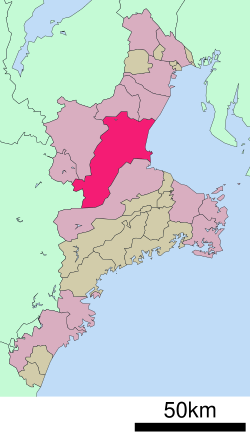Tsu, Mie
|
Tsu 津市 |
|||
|---|---|---|---|
| City | |||

Tsu City Hall
|
|||
|
|||
 Location of Tsu in Mie Prefecture |
|||
| Coordinates: 34°43′6.4″N 136°30′20.6″E / 34.718444°N 136.505722°ECoordinates: 34°43′6.4″N 136°30′20.6″E / 34.718444°N 136.505722°E | |||
| Country | Japan | ||
| Region | Kansai, Tōkai | ||
| Prefecture | Mie Prefecture | ||
| Government | |||
| • -Mayor | Yasuyuki Maeba (since May 2011) | ||
| Area | |||
| • Total | 711.11 km2 (274.56 sq mi) | ||
| Population (August 2015) | |||
| • Total | 279,304 | ||
| • Density | 393/km2 (1,020/sq mi) | ||
| Time zone | Japan Standard Time (UTC+9) | ||
| Symbols | |||
| • Tree | Zelkova serrata | ||
| • Flower | Azalea | ||
| • Bird | Japanese bush warbler | ||
| Phone number | 059-229-3110 | ||
| Address | 23-1 Nishi-Marunouchi, Tsu-shi, Mie-ken 514-8611 | ||
| Website | www |
||
Tsu (津市 Tsu-shi?) is the capital city of Mie Prefecture, Japan.
As of August 2015, the city had an estimated population of 279,304 and a population density of 393 persons per km2. The total area was 711.11 square kilometres (274.56 sq mi).
Tsu is located in east-central Kii Peninsula, in central Mie Prefecture. It stretches the width of Mie Prefecture, and is bordered by Ise Bay on the Pacific Ocean to the east, and Nara Prefecture to the west. Parts of the city are within the limits of the Murō-Akame-Aoyama Quasi-National Park.
Tsu has a humid subtropical climate (Köppen climate classification Cfa) with hot summers and cool winters. Precipitation is significant throughout the year, but is heaviest from May to September.
Tsu originally developed as a port town known as Anotsu (安濃津?) in the Nara and Heian periods. The port was destroyed by a tsunami in the 1498 Meiō Nankaidō earthquake. The town was rebuilt as a castle town and a post station by the Tōdō clan, daimyō of Tsu Domain under the Tokugawa shogunate. During the Edo period, it became a popular stopping point for travelers to Ise shrine, about 40 km to the southeast.
...
Wikipedia



